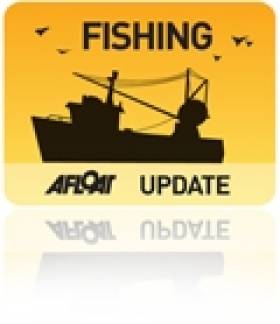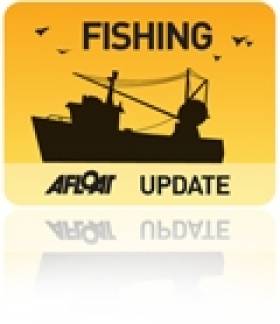Displaying items by tag: Skipper Expo
Ocean Energy, Angling & Fishing Expo in Seascapes Podcast
Hello and welcome aboard this weeks edition of your maritime programme, we have music from Molgoggers, we preview the Lewis Symposium presented by MaREI – Ocean Energy; Theory, Practice and Integration hosted by the Environmental Research Institute Beaufort Building, University College Cork by visiting the Seascapes archive and hearing from Emeritus Professor Tony Lewis ....the remarkable HMS Caroline the Battle of Jutlands only afloat survivor in Belfast soon to open as a heritage visitor attraction, Fergal Keane visits the annual Angling Expo in the National Show Centre held last weekend ..... and our competition for copies of “This Is the Burren” by photographer Carsten Krieger courtesy of The Collins Press; ....First here on Seascapes to the Raidio na Gaeltachta Studios in Derrybeg near Gweedore to hear from Hugh Bonner of Mara Media who publish The Irish Skipper and host the Skipper Expo with over one hundred exhibitors in Galway next weekend on Friday 4th and Saturday 5th March at The Galway Bay Hotel...
The Winter lecture 2015/16 season of the Glenua Sailing Centre continues with a double lecture programme at the March meeting entitled: ‘The Sea From Two Perspectives’.
The illustrated lectures will take place on next Thursday 3 March (20:00hrs) at the Poolbeg Yacht & Boat Club, Ringsend, Dublin. There will be an entry fee of €5 in aid of the R.N.L.I
The first lecture, “Art and The Sea - An Enduring Fascination” will be given by Jessica O’Donnell who is Collections Curator at Dublin City Gallery The Hugh Lane. Jessica is a graduate of Trinity College, Dublin and the University of St Andrews.
Jessica’s talk will explore how artists have been captivated by the sea from many perspectives including how the Impressionists loved portraying people at leisure by the sea; how safeguarding the freedom of the seas was represented in artworks commissioned as war time propaganda; to contemporary artists whose fascination with the sea and marine life continues to inspire.
The second lecture is entitled, “Putting Eyes In The Deep Ocean” by Dr Fiona Grant, Ocean Science & Information Services (OSIS), Marine Institute, Ireland. Fiona began her studies in geology before going on to specialise in marine geophysics and earth system dynamics. Her first job was as conservation coordinator for wild salmon and sea trout before taking responsibility for research infrastructures in the Marine Institute.
Dr Fiona Grant will focus on some of the challenges in observing the deep ocean environment, how to harness ocean energy in Galway Bay and present some of the latest results from studies in the Atlantic Ocean.....
The annual Ireland Angling Show was held in the National Show Centre in Swords in Dublin last weekend. ..........Fergal Keane went along for Seascapes.
Hi Marcus,
It's nearly 3 years since you put out a call on Seascapes to help us find people who had built IDRA 14 dinghies in the past or had plans that we didn't know about.Well, we're now coming towards the end of our project! We did meet with some listeners to your programme, who got in touch during that time and visited our project. Thought you might like to know how we're doing.
As we enter into the 70th anniversary year of the IDRA 14 Dinghy, we're delighted to be able to announce the launch date for the new wooden clinker-built IDRA 14 dinghy, being built in Clontarf, the first to be built in well over 35 years.
Look at it now............Riveting completed, floor bearers in place, spinny shute in place, foredeck on - we're ready now to put the deck on and close up the boat! :-) Find out more in our latest update.
Next to Emeritus Professor Tony Lewis of University College Cork , back in October of last year we were in Croke Park for an Ocean Energy Conference and we spoke to Tony ...
On Monday and Tuesday the Environmental Research Institute Beaufort Building hosts MaREI –The Lewis Symposium on Ocean Energy : Theory Practice and Integration at the National Maritime College of Ireland .....speakers will include Professor Tony Lewis ; Eoin Sweeney on Marine Renewables in Ireland ; Professor Stephen Salter , Emeritus Professor University of Edinburgh ; Professor Trevor Whittaker , Queens University Belfast on the Industrial History of Ocean Energy and Professor Alistair Borthwick , University of Edinburgh on tides and Tidal Power , we’ll have more detail on the speakers and topics at the Lewis Symposium and we’ll have a full report on Seascapes next week....,.
The War at Sea is rarely considered when discussing the impact of the First World War but, although it involved far fewer men on the front line, keeping the seas safe and the vital supplies flowing to feed the Army and the people of Britain and Ireland cannot be overlooked. From across Ireland over 10,000 men served in the Royal Navy, but many tens of thousands more served in the merchant fleet, continued to fish despite the hostile submarine threat, provided essential rescue services off our coasts and maintained the essential industries directly linked to the sea.
31st May 2016 is the Centenary of the Battle of Jutland, which was the most significant naval engagement of WW1. This is the chosen date to mark the contribution of all involved in war and life at sea 1914 – 1918 with a Commemoration to the Irish Sailor in the Great War. The event will be run in Belfast next to Jutland’s only afloat survivor, HMS Caroline, and will include her official opening as a heritage visitor attraction. The commemoration will connect people in maritime activity a hundred years ago with descendants, and to those engaged in similar activity today.
Galway Skipper Expo 2015 Set To Be Biggest & Best Yet
#Fishing - Over 110 companies will be exhibiting at Skipper Expo International Galway 2015 on 6-7 March.
This is the event's biggest exhibitor attendance ever – and organisers say it's confirmation of the important place the flagship fisheries show holds in the industry calendar.
Sponsored by Bord Iascaigh Mhara (BIM), this year’s 11th anniversary Galway event in Ireland is shaping up to be the best yet, thanks to the huge amount of interest from both exhibitors and visitors from all over Ireland, the UK and beyond.
Indeed, such has been the demand for stand space that two additional rooms have been secured at the event venue at the Galway Bay Hotel to accommodate this extra surge in interest.
Star attractions will include boat displays, pool demos and the superb exhibitors’ seafood buffet. There will be something to interest every visitor, thanks to the vast range equipment and service suppliers covering all sectors of the fishing industry.
Sharon Boyle of show organisers Mara Media said: “We have been overwhelmed by the huge interest in Skipper Expo International Galway 2015 and it promises to be a fantastic event. The record number of exhibitors underlines the dynamism and innovation that lies at the heart of our fishing industry.”
Skipper Expo 2015 opens on Friday 6 March at 10am running till 5pm, continuing on Saturday 7 March from 10am to 4pm. Admission is free, and more details can be found at the Mara Media website HERE.
Galway Skipper Expo This Weekend Celebrates 10 Years
#SkipperExpo - Galway's Skipper Expo celebrates its 10th anniversary when it opens this weekend 7-8 March at the Galway Bay Hotel.
Supported by Bord Iascaigh Mhara (BIM) and Mullion, the international fisheries show will showcase the vast range of products and services available to the fishing industry.
And according to organisers Mara Media, the hallmark of the expo is its friendly atmosphere combined with a proven track record in being a great place to do business.
Visitors from fishing ports throughout Ireland are expected to be bolstered by strong contingents from Scotland and other parts of the UK, not to mention continental Europe.
Skipper Expo 2014 opens on Friday 7 March at 10am running till 5pm, continuing on Saturday 8 March from 10am to 4pm. Admission is free, and for more details visit the Mara Media website HERE.































































